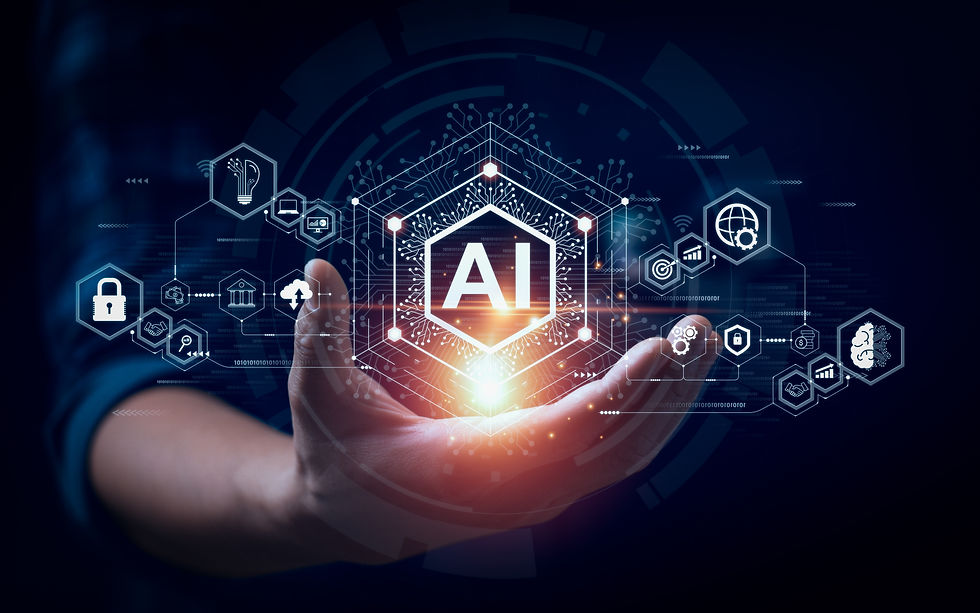What are the realities of AI?
- swatkiss
- Jan 18, 2024
- 6 min read
Updated: Mar 8, 2024

In today's fast-paced world, businesses that fail to adapt to new and progressive technologies like AI risk falling behind and losing their competitive edge. AI is no longer just a buzzword but a transformative technology changing how we live and work. In this article, we'll explore the benefits of AI and how businesses can leverage this technology to enhance their operations, streamline processes, and improve customer experiences. Challenges and limitations will also be discussed. Outline:
1. Introduction to AI
2. Benefits of AI for businesses
3. Use cases for AI in different industries
4. Challenges and limitations of AI
5. Best practices for implementing AI in business operations
6. Conclusion
What is AI
What are the realities of Artificial Intelligence (AI)? It is a branch of computer science that focuses on creating intelligent machines that can perform tasks that typically require human intelligence, such as learning, problem-solving, decision-making, and understanding natural language. AI uses algorithms and mathematical models to analyse data and make predictions or decisions based on that data. AI can be applied to a wide range of industries, including healthcare, finance, entertainment, and transportation, among others.
Benefits of AI for Businesses
The realities of Artificial intelligence (AI) have significantly impacted businesses in recent years. With its ability to analyse large amounts of data and make predictions based on that data, AI is helping companies make more informed decisions and improve their operations in various ways.
One of the most significant impacts of AI on businesses is the ability to automate tasks that humans once performed. This can lead to substantial cost savings and increased productivity. For example, AI-powered chatbots can handle customer service inquiries, freeing up human customer service representatives to address more complex issues.
AI in Different Industries
AI is also helping companies improve their marketing efforts by providing more personalised and targeted messaging to customers. By analysing customer data, AI can predict what products or services a customer is most likely to be interested in and deliver personalised recommendations.
In addition, AI is helping businesses improve their supply chain management by providing real-time visibility into inventory levels, shipping times, and other critical metrics. This enables companies to make more informed decisions about when to reorder products and how much inventory to keep on hand.
Overall, the impact of AI on businesses is significant and will continue to grow as the technology evolves. While there are challenges and risks involved with adopting AI, the benefits are clear, and companies that embrace this technology will likely be more competitive and successful in the long run.
What are some of the Challenges and limitations of AI
While there are many benefits to using artificial intelligence (AI) in the workplace, there are also some potential negative impacts on human resources (HR).
One of the main concerns is that AI could lead to job displacement. As AI becomes more advanced, it can perform tasks that were once done by humans, leading to job losses in certain industries. This could significantly impact HR, as they will need to manage the transition for employees affected by these changes.
Another concern is that AI could lead to bias in hiring and other HR processes. While AI is designed to be objective, it can still be influenced by the data it is trained on. If the data used to prepare the AI is biased, then the AI may also be limited in its decision-making. This could lead to discrimination in hiring, promotions, and other HR processes, which could have legal and ethical implications for businesses.
There is also a risk that AI could lead to a lack of human interaction in the workplace. As more tasks are automated, employees may feel less connected to their work and each other. This could decrease employee morale and productivity, ultimately impacting the bottom line.
Best practices for implementing AI in business operations
Implementing AI in business operations can be complex, but following best practices can help ensure a successful implementation. Here are some best practices for implementing AI in business operations:
1. Identify business objectives: Before implementing AI, it is essential to identify the business objectives the technology should help achieve. This will help you determine the specific use cases for AI and ensure that the technology is aligned with the overall business strategy.
2. Start small: It is usually best to start with a small project or use case when implementing AI. This will allow you to test the technology and identify any issues or challenges before scaling up. Once you have proven the value of the technology, you can expand its use to other areas of the business.
3. Choose the right AI solution: There are many different AI solutions available, and choosing the right one for your business can be challenging. It is essential to assess your needs carefully and select a solution that can address your specific use case effectively.
4. Develop a data strategy: AI relies on large amounts of data to provide insights and make predictions. Developing a data strategy that includes data collection, storage, and analysis is crucial to ensure that the AI solution has access to high-quality data.
5. Invest in training: AI requires specialised skills and knowledge, and it is essential to invest in training for your employees to ensure they can work effectively with the technology. This may include training on data analytics, machine learning, and other AI-related topics.
6. Ensure transparency and accountability: AI can be complex and opaque, making it difficult to understand how decisions are made. It is essential to ensure transparency and accountability in the AI system, including documenting and explaining the decision-making process.
7. Monitor and evaluate performance: It is essential to monitor and assess the performance of the AI solution regularly. This will help you identify any issues or areas for improvement and ensure that the technology continues to provide value to the business.
While AI can transform HR and improve many aspects of the workplace, businesses must be aware of the potential negative impacts and take steps to mitigate them. This may include investing in upskilling and reskilling programs for employees, ensuring that AI is trained on unbiased data, and finding ways to maintain human interaction and connection in the workplace. By following these best practices, businesses can implement AI effectively and realise the benefits of this transformative technology.
Conclusion
The cost to business of not moving with the times and adapting to progressive technology
The realities of AI and the cost to a business of not moving with the times and adapting to progressive technology can be significant. Here are some potential costs a business may face if it fails to embrace AI:
1. Loss of competitiveness: Businesses that don't adopt AI may be left behind by competitors who do. AI can help businesses streamline operations, reduce costs, and improve their products and services. Companies that fail to adopt AI may find it difficult to compete with more agile and technologically advanced businesses.
2. Higher costs: Without the use of AI, businesses may need to hire more staff to perform tasks that could be automated. This can lead to higher labour costs, which can eat into profits. In addition, without the insights and efficiencies that AI can provide, businesses may experience higher material and operational costs.
3. Lower productivity: By not adopting AI, businesses may miss out on opportunities to increase productivity. AI can automate many tasks, allowing employees to focus on more critical and creative work. Without this automation, employees may be bogged down with repetitive tasks, leading to lower productivity and job satisfaction.
4. Poor decision-making: Without the insights and analytics provided by AI, businesses may be making decisions based on incomplete or inaccurate information. This can lead to poor decision-making, which can have significant consequences for the business.
Overall, the cost to a business of not adopting AI can be significant. While upfront costs may be associated with implementing AI, the long-term benefits of competitiveness, productivity, and profitability can far outweigh these costs.
List for Further Reading:
1. "The Impact of AI on Business Operations" by Harvard Business Review 2. "AI in the Enterprise: From Experimentation to Adoption" by McKinsey & Company
3. "The Future of Employment: How Susceptible are Jobs to Computerisation?" by Oxford Martin School
4. "The AI Revolution: The Road to Superintelligence" by Wait But Why





Comments